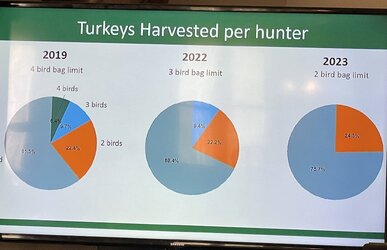I'm not a scientist or a statistician, and my opinions certainly may be wrong as well. I really, really hope I am. There is literally nothing on earth I like to do more than hunting turkeys. If I knew it wouldn't hurt the turkey population long term, I would LOVE for the season to run March 1 to June 1 with a 10 bird limit. But turkeys cannot sustain that. However, if a conclusive, peer reviewed study comes out convincingly showing that our "Saturday closest to April 1" start date has no adverse effect on the turkeys, praise Jesus. Move it back and turn us lose. But that's not what this paper is. Nothing has been proven or disproven yet, so I'm a "err on the side of caution" guy. Especially with somethin as important as turkeys.
And I have listened to Harper's presentations and podcasts plenty. To be fair, he was in full denial of Chamberlain's early start date theory before this season delay study even began. I don't think Harper and Chamberlain like each other much. Chamberlain actually offered to come give a presentation about his early research on the subject in 2020, before TN started this part of the study. It would been free from our perspective, as Chamberlain has funds available through UGA for travel and lodging when he travels for presentations. Our commission declined his offer because Harper didn't want him to come. And forgive my skepticism, but this student's thesis paper reads as though the study sought to disprove the early start date theory, rather than just evaluating it. Although they are supposedly studying the delay's impact on reproductive parameters, they excluded re-nesting attempts from their analysis. Why? Re-nesting is fairly common. The study mentions that, on average, hens will attempt a second next 24 days after their first nest fails. Isn't is plausible that the early removal of breeding-age male turkeys might negatively impact re-nesting hens, and therefore overall reproduction? But they excluded it. And yes, I looked at Table 2.3. I don't understand any of it. Too many Greek letters for me. If you, or anyone else knows how to read the data, I would love an explanation.
View attachment 221413
But table 2.2, and the data analysis (pp. 22-30) I do understand a little.
View attachment 221418
I think everyone will agree that nest success (i.e., the percentage of nests that successfully hatch a turkey) is an important measure of reproductive success. I'm repeating myself, but I think it bears repeating. We delayed the season in three counties, and left it the same in two. In the three counties with the season delay, nest success increased >20% in the two years immediately following the delay. In the two counties that did not delay the season, nest success
decreased approximately 5%. As an aside, I'm not saying that nest success always results in increased populations. If there are enough mesopredators, maybe all the poults get eaten whether nest success is 5% or 50%. If we have a terribly wet, cool spring, maybe all the poults die no matter how many hatch. There are a lot of moving parts and a lot of ways for baby turkeys to die. But it cannot be disputed that, having a higher percentage of nests successfully producing poults is a step towards having more adult turkeys on the landscape. This is where the paper lost me. The actual numbers show a clear, significant increase in nest success following the delay. I fully realize that correlation does not always equal causation, but yugo -- if we delayed the season and immediately saw a 20-25% improvement in nest success, how/why does the next chart claim that there was "no documented effect" on nest success?
As noted, I'm not a scientist or statistician. But, I have a good friend who is. He's a UT professor with a PhD in it. I'm sorry to be the "well, I have a friend who says . . ." guy, but he's the only person I know who actually understands the math here. My friend is not a turkey hunter at all, and doesn't give a damn about the reproductive rates of eastern wild turkeys. But he understands what all those Greek letters mean. I asked him to look at the paper and give his thoughts. I did not tell him mine. His first comment was that the paper makes no mention of COVID, despite a huge increase in hunting pressure during some of this study. His second comment was that there is "very weak support" between the actual data and the conclusion reached, based purely on math considerations that I don't understand. He emphasized (repeatedly) that this is a grad student's thesis paper, not a peer reviewed study, and he had serious doubts that the paper could ever withstand the peer review process. To be clear, I am not trying to disparage the kid who wrote the paper. I am certain that some of the academic papers I wrote in grad school could be thoroughly shredded by anyone with a strong understanding of the subject matter. But, that's part of my point. There is a big difference between a thesis paper written by someone trying to impress his professor (Harper in this case) and get his degree, versus a published, peer reviewed scientific paper.
Maybe I'm just simple minded, but until someone can explain to me how a 21.6% increase in nest success in the delayed counties, with a simultaneous decrease in nest success one county over, equals "no documented effect," I will remain skeptical. I hope he's right, but it seems to me that there is a disconnect between the data and the conclusions drawn.


